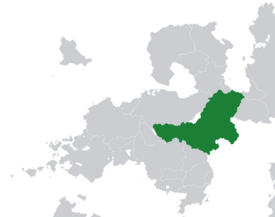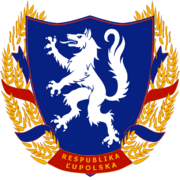State of Luepola: Difference between revisions
No edit summary |
No edit summary |
||
| (20 intermediate revisions by 2 users not shown) | |||
| Line 5: | Line 5: | ||
|region = | |region = | ||
|era = {{wp|Late modern period}} | |era = {{wp|Late modern period}} | ||
|year_start = | |year_start = 1951 | ||
|year_end = | |year_end = 1980 | ||
|life_span = | |life_span = 1951–1980 | ||
|event_start = [[Krassfurt Memorandum]]<br><small>(Formation)</small> | |event_start = [[Krassfurt Memorandum]]<br><small>(Formation)</small> | ||
|date_start = 22 November | |date_start = 22 November | ||
|event1 = | |event1 = [[March Uprising]] | ||
|date_event1 = | |date_event1 = 13 March | ||
|event2 = | |event2 = | ||
|date_event2 = | |date_event2 = | ||
| Line 21: | Line 21: | ||
|event5 = | |event5 = | ||
|date_event5 = | |date_event5 = | ||
|event_end = | |event_end = Dissolution | ||
|date_end = | |date_end = 1 January | ||
|event_pre = | |event_pre = | ||
|date_pre = | |date_pre = | ||
| Line 29: | Line 29: | ||
|p1 = People's Republic of Luepola | |p1 = People's Republic of Luepola | ||
|flag_p1 = Flag_Luepola_PR.png | |flag_p1 = Flag_Luepola_PR.png | ||
|p2 = | |p2 = Vierz occupation of Luepola (1947–1951) | ||
|flag_p2 = | |flag_p2 = Flag_of_Vierzland.png | ||
|p3 = | |p3 = | ||
|flag_p3 = | |flag_p3 = | ||
| Line 37: | Line 37: | ||
|p5 = | |p5 = | ||
|flag_p5 = | |flag_p5 = | ||
|s1 = Republic of Luepola | |s1 = Luepola{{!}}Republic of Luepola | ||
|s2 = Reichskommissariat Luepola ( | |s2 = Reichskommissariat Luepola (1980-1985) | ||
|s3 = | |s3 = | ||
|s4 = | |s4 = | ||
| Line 44: | Line 44: | ||
|s6 = | |s6 = | ||
|flag_s1 = LuepolaFlagModern.png | |flag_s1 = LuepolaFlagModern.png | ||
|flag_s2 = | |flag_s2 = Flag_Luepola_VierzOcc.png | ||
|flag_s3 = | |flag_s3 = | ||
|flag_s4 = | |flag_s4 = | ||
| Line 72: | Line 72: | ||
|government_type = [[wikipedia:Federation|Federal]] [[wikipedia:presidential_system|presidential]] [[wikipedia:Republic|republic]] | |government_type = [[wikipedia:Federation|Federal]] [[wikipedia:presidential_system|presidential]] [[wikipedia:Republic|republic]] | ||
|title_leader = President | |title_leader = President | ||
|leader1 = [[ | |leader1 = [[Christian Dobrovitch]] <small>(first)</small> | ||
|year_leader1 = | |year_leader1 = 1951–1962 | ||
|leader2 = [[ | |leader2 = [[Emil Ivanušić]] <small>(last)</small> | ||
|year_leader2 = | |year_leader2 = 1980 | ||
|legislature = | |legislature = [[Sliet]] | ||
|upper_house = | |upper_house = [[Great Assembly]] <br> ''Veliki Sbor'' | ||
|lower_house = | |lower_house = [[Popular Assembly (Luepola)|Popular Assembly]] <br> ''Ľudovi Sbor'' | ||
| | |stat_year1 = 1952 | ||
| | |stat_pop1 = 60,574,936 | ||
|stat_year2 = 1979 | |stat_year2 = 1979 | ||
|stat_pop2 = 75,089,374 | |stat_pop2 = 75,089,374 | ||
| Line 89: | Line 89: | ||
}} | }} | ||
The '''State of Luepola''' ( | The '''State of Luepola''' ({{lang-lupl|Država Ľupolska|l}}) was a country in eastern [[Patyria]] and the predecessor of the modern [[Luepola|Republic of Luepola]], with which its borders are contiguous. Officially a federal republic, the country was effectively a {{wpl|client state}} of the [[Vierz Empire]], which exercised significant control in the State's domestic and foreign affairs alike. The State of Luepola was established in the [[Krassfurt Memorandum]] of 1951, ending the period of direct {{wpl|Martial law|military rule}} by the Vierz ''[[Reichswehr (Vierzland)|Reichswehr]]'' in the aftermath of the [[Great War (Vasarden)|Great War]]; it was dissolved in a joint resolution by the [[Sliet]] and President [[Emil Ivanušić]] on 1 January 1981, during the [[Luepolan War]]. The period during which Luepola was under Vierz control has been labelled the '''Silent Era''' ({{lang-lupl|Mlčavši Rok|}}), referring to both the [[Silent War]] over which the State spanned, and to the perceived repression of Luepolan {{wp|sovereignty}} and {{wp|national consciousness}}. | ||
{{Luepola Topics}} | |||
[[Category:Vasarden]] | [[Category:Vasarden]] | ||
[[Category:Silent War]] | |||
[[Category:Luepola]] | [[Category:Luepola]] | ||
Latest revision as of 07:51, 12 January 2021
This article is incomplete because it is pending further input from participants, or it is a work-in-progress by one author. Please comment on this article's talk page to share your input, comments and questions. Note: To contribute to this article, you may need to seek help from the author(s) of this page. |
State of Luepola Država Ľupolska | |||||||||||||
|---|---|---|---|---|---|---|---|---|---|---|---|---|---|
| 1951–1980 | |||||||||||||
|
Flag | |||||||||||||
| Capital | Prishek | ||||||||||||
| Official languages | Luepolan Vierz | ||||||||||||
| Common languages | |||||||||||||
| Government | Federal presidential republic | ||||||||||||
| President | |||||||||||||
• 1951–1962 | Christian Dobrovitch (first) | ||||||||||||
• 1980 | Emil Ivanušić (last) | ||||||||||||
| Legislature | Sliet | ||||||||||||
| Great Assembly Veliki Sbor | |||||||||||||
| Popular Assembly Ľudovi Sbor | |||||||||||||
| Historical era | Late modern period | ||||||||||||
• Krassfurt Memorandum (Formation) | 22 November 1951 | ||||||||||||
| 13 March | |||||||||||||
• Dissolution | 1 January 1980 | ||||||||||||
| Population | |||||||||||||
• 1952 | 60,574,936 | ||||||||||||
• 1979 | 75,089,374 | ||||||||||||
| Currency | Luepolan Grivna (Ғ) | ||||||||||||
| |||||||||||||
The State of Luepola (Luepolan: Država Ľupolska) was a country in eastern Patyria and the predecessor of the modern Republic of Luepola, with which its borders are contiguous. Officially a federal republic, the country was effectively a client state of the Vierz Empire, which exercised significant control in the State's domestic and foreign affairs alike. The State of Luepola was established in the Krassfurt Memorandum of 1951, ending the period of direct military rule by the Vierz Reichswehr in the aftermath of the Great War; it was dissolved in a joint resolution by the Sliet and President Emil Ivanušić on 1 January 1981, during the Luepolan War. The period during which Luepola was under Vierz control has been labelled the Silent Era (Mlčavši Rok), referring to both the Silent War over which the State spanned, and to the perceived repression of Luepolan sovereignty and national consciousness.


